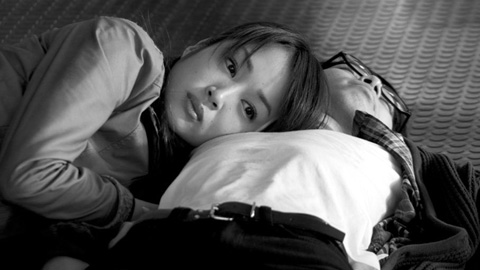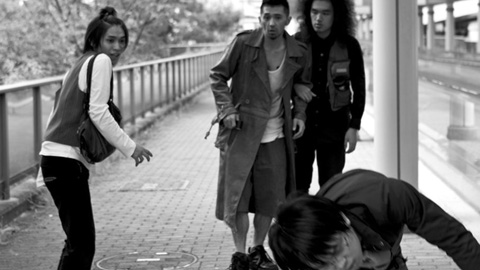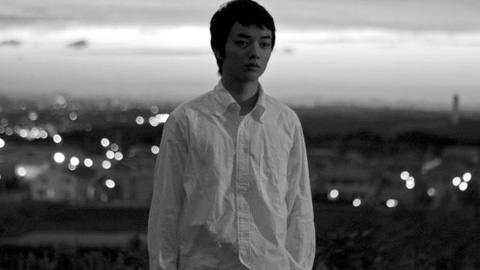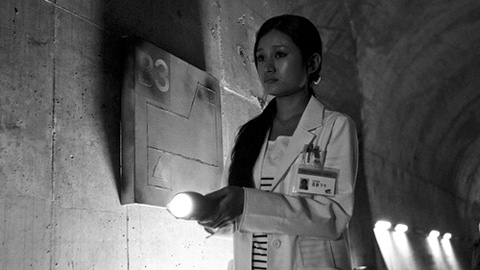Isn’t Anyone Alive?
- Year
- 2012
- Original title
- Ikiteru Mono wa Inainoka
- Japanese title
- 生きてるものはいないのか
- Director
- Cast
- Running time
- 113 minutes
- Published
- 3 September 2012




by Tom Mes
There was a time when Sogo Ishii could be considered a visionary. A prophet, almost: a filmmaker who was not only in touch with the times, but ahead of them – as the spearhead of a generation of do-it-yourself filmmakers, as an innovator of style and form, and as a commentator on society at large.
Ishii (then still known by his birth name Toshihiro Ishii) made a splash during the second half of the 1970s at the earliest editions of the now renowned PIA Film Festival. The 17-minute Panic High School (Koko Dai Panikku) and the one-hour Attack! Hakata Street Gangs (Totsugeki! Hakata Gurentai), both shot with groups of friends in Ishii's native stomping ground of northern Kyushu, were reason enough for major studio Nikkatsu to invite him to direct a professional, feature-length remake of the former film. Ishii was still only a student at the time. The experience famously went sour when his veteran co-director Yukihiro Sawada effectively pushed Ishii off his own set, but the vengeance was all the sweeter: Ishii's self-financed Crazy Thunder Road was bought and released nationwide by Toei, making its student director the object of worship by jishu eiga filmmakers all across Japan.
Ishii’s films from this period, those made in what he himself sums up as “The Punk Years” (the name of the DVD box set containing the films he made between 1976 and 1983), were gripping documents of Japan’s punk and biker scenes, and formal precursors to – and influences on – any Japanese filmmaker who later experimented with speed, rapid-fire montage and musical interludes: Miike, Tsukamoto, Nakashima, Toyoda – the list goes on.
The films from the second phase of Ishii’s career, grouped into another set of discs dubbed “The Psychedelic Years”, are marked out less for their hallucinogenic qualities (although August in the Water / Mizu no naka no Hachigatsu and The Master of Shiatsu / Shiatsu Oja could certainly be called hallucinatory experiences) than for their eerie ability to spot social trends before they happen. Case in point: Angel Dust (Enjeru Dasuto, 1994), a film about killings perpetrated on commuters on the Tokyo subway system by an obscure religious cult – released a full year before the Aum sarin gas attacks made world headlines.
In its unsettling tendency to ask probing questions without providing answers, and in its portrayal of sudden, inexplicable eruptions of antisocial behaviour in everyday individuals, Angel Dust also formed a notable precursor to the films with which Kiyoshi Kurosawa would make his name internationally a few years later – Cure and Charisma, in particular.
A gap of almost a decade separates the two phases of Ishii’s career, a gap that reopened in the past few years, which saw only intermittent activity from Ishii in the wake of the commercial disasters that were the pairing of Gojoe and Electric Dragon 80,000V. Though rousing theatrical experiences, the costly back-to-back production of the neo-chanbara spectacle and the deafening audio-visual assault sank producer Takenori Sento’s prestigious production outfit Suncent Filmworks, leaving Ishii back on his own, with the label of tainted goods attached for good measure.
Filmmaking activity since then has only been intermittent – and disappointing. The 57-minute Dead End Run (2003) was an excuse for further experimentation with sound that didn’t even bother to masquerade as a feature. Narratively, it was a poor copy of Tom Tykwer’s Run Lola Run, with the same scenario played out three times, but never actually going anywhere – the title, at least, was accurate. Mirrored Mind was lovely to look at, but its Zen-philosophical message felt smeared out over an hour’s running time and would have been more effectively served up in shorter form. Ishii next accepted an offer to teach at Kobe Design University, which, combined with the efforts at recuperating the rights to, the restoration and the release of his back catalogue, kept him away from actually making films for several years.
And so, at last, we come to 2012 and the return of Sogo Ishii to feature filmmaking. Rechristening himself, once more, as Gakuryu (“Mountain Dragon”) Ishii to indicate a fresh start and a renewed sense of vigour, the director delivers Isn’t Anyone Alive? It seems he once again hit the bull’s eye with the title, for despite his well-publicised best intentions, there really isn’t much life in his latest offering. The plot is as wafer-thin as Dead End Run’s: young people sit around and talk until, one by one, they are seized by convulsions and die in terrible agony.
A plot is but a plot, and any perceived lack of substance could be easily compensated if the characters were interesting and the whole spectacle had some meaning. Unfortunately, this film offers neither. Isn’t Anyone Alive? plays like a rerun of what Kiyoshi Kurosawa – just to remind you: the man whose best work Ishii once prefigured – was doing over a decade ago with Pulse and Barren Illusions, except drained of anything that made those films interesting and relevant, leaving only hollow form, motions to go through, clichés to reiterate. Ishii’s visions of a society on the threshold of Apocalypse look like they were picked from the bin in Pulse’s editing room: wide shots of tower blocks with plumes of smoke rising from them in the distance, while trains have halted in their tracks and motionless cars pile up on the expressways.
Among the dozens of young faces in the cast, only comparative veterans like Kiyohiko "KEE" Shibukawa and Jun Murakami manage to inject any sort of humour and lightness - in short: life – into the proceedings; for most characters it therefore makes little difference whether they are alive or dead. Shota Sometani, the ostensible star of the film, recently seen to much better effect in Sion Sono’s Himizu and Kota Yoshida’s Yuriko’s Aroma, stands around doing nothing at all. The endless dialogue exchanges between the actors do not even add up to scenes, and it is indicative of a desperation to inject some kind of dynamics – instead of adding meaning – when Ishii starts toying with split screens and odd forms of blocking.
Fresh start or not, the man who was once a prophet is now far behind the times, to the point of being derivative and becoming, shudder to think, inconsequential.